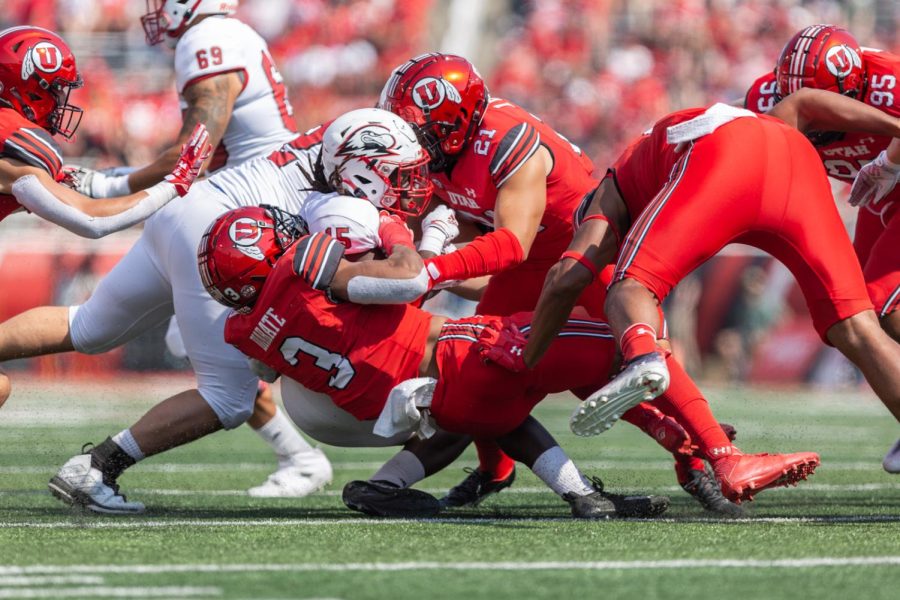The Lasting Dangers of Contact Sports
University of Utah linebackers Mohamoud Diabate (#3) and Karene Reid (#21) make a tackle in the game against Southern Utah University on Sept. 10, 2022 at Rice Eccles Stadium in Salt Lake City. (Photo by Jack Gambassi | The Daily Utah Chronicle)
November 9, 2022
Clearly, sports impact fans across the globe, with some getting team logos tattooed on them, having several jerseys in their wardrobe and flying across the country to make a game. However, the impact on the participants of those sports is much greater.
One of the most commonly known injuries in sports is chronic traumatic encephalopathy, a condition primarily seen in football players. The essence of CTE is repeated concussions that bruise the brain, eventually causing injuries that last a lifetime.
A person with CTE may not start showing symptoms for years after the injury occurred. Symptoms include memory loss, impulse control problems, aggression and depression, but the condition can only be formally diagnosed posthumously.
Many articles have shown that the risk of developing CTE doubles after just three years of playing professional football, and the results of CTE are often deadly. The 2008 Florida Gators are a common example of these types of injuries.
The Gators won the NCAA Championship in 2008, led by Tim Tebow, the first sophomore to win the Heisman trophy. But for many players on the team, this wouldn’t be the only defining moment of their career.
Forty-one of the 121 players on the 2008 Florida team would end up being arrested. But the most known player is former tight-end Aaron Hernandez.
Hernandez was a bright light on the Gators team and went on to play professionally for the New England Patriots. But his career came to a short end when he was arrested in 2013 for suspected murder.
Hernandez was waived from the Patriots and charged with first-degree murder. He later would commit suicide while in prison. His brain was also found to show severe signs of Stage 3 CTE. Although this doesn’t directly explain his behavior, it is a sure sign that CTE can impact many lives.
Hernandez had very severe CTE, making it into Stage 3. The most common stage is Stage 2, which also exhibits unusual behaviors.
Another former NFL player, Phillip Adams, suffered from Stage 2 CTE and murdered six people on April 7, 2021 before committing suicide. Although Adams had previously reached out to the NFL about his worsening condition, he was unable to receive help.
Even though symptoms of CTE don’t show until later in life, this is still a present issue, and the difficulties with diagnosing CTE in living athletes makes its true impact unknown. The NFL is researching different helmets that may protect the brain better, but there is only so much that they can do.
Dr. Lee Goldstein, a physicist and CTE researcher at Boston University said to the New York Times, “My fear is that a better helmet will give false reassurance.”
The NFL has taken additional steps such as penalizing blindside blocks, a very dangerous and unpredictable hit. They also pledged $100 million to support research in neuroscience-related areas in 2016.
But the fact of the matter is that fans love to watch football, and the sport isn’t going to disappear anytime soon. The best that we can do in the present is to provide players with the safest way to participate in the sport they love.
Football isn’t the only sport where the injury is a problem. All contact sports such as rugby, boxing, hockey and even soccer have documented cases of CTE.
Soccer is the world’s most popular sport, with over 3.5 billion viewers tuning in for the 2018 World Cup in Russia. The first MLS player to be diagnosed with CTE was former Kansas City defender Scott Vermillion, who was diagnosed with CTE after his accidental drug overdose in December 2020.
Although soccer is a contact sport, it doesn’t see the same level of contact and big hits that football does. But this new research shows that even a minimal level of contact may be dangerous.
This isn’t to say that soccer players need helmets, but there is a lot of research to be done on CTE — it is a very complex injury, and there is no clear-cut answer as to what can be done to solve it.
Although fans love to watch hard hits and exciting plays, these can have long-lasting effects and impact many lives.












